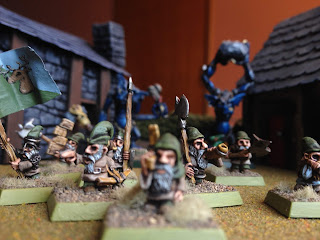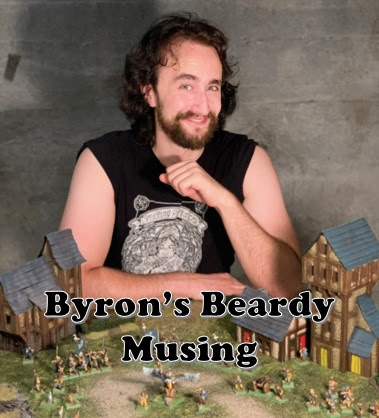One on One is fine, but what about actual combats?
 |
| Guarden Gnomes confront a mob of savage orcs |
Initial disclaimer: I fully appreciate that for others number crunching and meta-gaming cuts against the spirit of Oldhammer and cooperative-fun tabletop games. My intent here is not to promote meta-gaming nor that people should field gnomes as an advantageous team; rather, I do it just to press home the idea that gnomes are, in fact, fair. That is, I sense a general preconception from most that gnomes are simply unplayable and that their lack of Toughness makes them a liability. Most folks don't want to meta-game, but alternatively, they don't want their defeat to be a pre-drawn conclusion.
After writing my previous article weighing the merits of gnomes, I came to reconsider my methods. In my previous article I compared gnomes to various other races, model to model. This presented a lot of problems for real application. For example I compared gnomes with gear to elves and dwarves without gear. And, I compared Gnomes without gear to goblins with gear.There is also the consideration of point density. For example, a unit of Dwarf Hammerers is very expensive. A dwarf player can sink many points into the unit, and a gnome player confronting them may have more numbers, but the advantage of numbers has limited returns. For example a unit of 20 Hammerers with standard and musician will cost 352 points. For that same cost gnomes could field 37 gnomes with light armor, shield and spear, as well as a standard and musician. Even optimised, there is a lot of lost value for the gnomes.
If the dwarves deploy 5 wide and 4 deep, the gnomes can meet that by deploying 6 wide and 4 deep to take advantage of being wider to get an additional model in play (yes technically they could be 7 wide, but perfectly lining up corner-to-corner to get that extra person, doesn't happen in reality, only with ponderous abstractions done by the players.) Being 6x4 means that they are able to take advantage of 24 gnomes. What do the other 13 do? They would essentially be twiddling their tiny thumbs.
So, in light of this, how do we say whether a model is good or not?
More data points of course! More points of comparison.
Man (and gnomes) is the measure of all things. ~ Protagoras
To that end, I have compared 200 points of Spear, light armor, and shield armed gnomes to 200 points of Empire Halberdiers, and 200 points of Empire Ersatz Pikemen with light armor. I have compared them by stacking up how these 3 unit types would fair against a myriad of other Oldhammer foes of the same points value.The confusing chart below shows the statistical combat resolution difference between the unit types in question relative to a slew of enemies. That is, in initiative order, I multiplied the probabilities of hitting, wounding, and armor save by the optimum unit formation (frontage and ranks minus casualties.) In many situations this means fractions of hits becoming smaller fractions of wounds and tinier fractions passed the armor save. The values that are presented reflect the statistical differences in combat resolution vs a given foe. A greater positive value indicates a higher likelihood of victory, and a lower value indicates a greater likelihood of defeat. Also, unless stated, it is assumed neither side charged(except for cavalry) or followed up, which I understand is an impossible assumption.
Example:
Let's say that we have 200 points of Ersatz Pikemen with light armor (20 models plus musician and standard) arrayed 5x4 fighting 200 points of Gnomish Spearmen ( 20 models plus musician and standard.)
 |
| Burgher Gnomes fight off massed Snotlings in a constrained space. |
The pikemen attack first with their higher initiative. They have WS3 against the Gnomes WS4. So they hit on a 5+ (1/3.) Then, they have Strength 3 against the Gnomes 2 Toughness, so they wound on a 3+ (2/3.) The Gnomes have shield and light armor which saves on a 5+, so 2/3 of wounds pass. The pikemen have Pikes so they have 5( front rank)+5/2 (second rank) +5/3 (third rank) +5/4 (fourth rank) attacks or 10.41 attacks. Multiplied together this equates to 1.54 wounds on the gnomes before they respond. The Gnomes hit on a 4+ (1/2) and wound on a 4+. The pikemen have light armor, so 5/6 of wounds pass. The gnomes have spears so they have 5 (front rant) +5/2 (second rank) -1.54 (casualties) attacks. This means that in reply the gnomes cause 1.24 wounds. Since both sides have +3 ranks and standards, their difference in combat resolutions is .3 in favor of the pikemen.
First some observations that aren't clearly conveyed in the simulation.
1. In most instances the largest sources of combat resolution were rank bonuses and standard bearers. To a veteran player this is common intuition, that one should nab as many guaranteed points as possible before committing to combat. Expensive units suffered from the trade-off between ranks and frontage since they were limited in numbers. Larger units of these elite troops would be much harder opponents getting the rank bonuses and their combat abilities.
2. Having multiple attacks is very potent, but only where one has the WS and/or frenzy to make it matter. Orcs with additional hand weapons were removed from the list since they were unable to hit with one of their weapons due to the -2 to hit modifier on left hands.
3. While the dark elf riders and Empire knights don't appear to score well on here, that's because they couldn't afford extra ranks or standards. Both inflicted many casualties. They may not fair as well directly fighting, but their large casualties suggest that with a smaller unit providing ranks, a hard hitting cavalry unit will win you extra combat resolution. These units should not be discounted.
Now observations that are easy to see in the simulation
1. Helblitzen are bad. They lose against nearly every opponent, except Impi, and Trolls. Which is a shame since they are required troops.
2. Gnomes with spear appear to be relatively on par with Ersatz Pikemen. Though a unit of Pikemen would have a slight edge (-.3) over gnomish spearmen, gnomish spearmen fair better than pikemen in more situations than pikemen fair better than gnomes.
3. Pikes are good. Perhaps some gnomish pikemen should be in order?
| Gnomes w/ spear light armor shield | Helblitzen | Ersatz w/ pike and light armor | |
| Slann warrior priest with shield | -0.6 | -2.5 | -0.9 |
| Dwarf w/ pike & light armor | -0.6 | -1.2 | -0.5 |
| Witch elf with add hand; frenzied | -0.6 | -1.3 | -1.0 |
| Nulner pike w/ heavy armor | -0.5 | -1.2 | -0.5 |
| Black Skaven w/ halberd & light armor | -0.06 | -1.04 | 0.3 |
| Goblins w/ spears, shield light armor | 0.03 | -0.1 | 0.7 |
| Doomsteed w/ Shield, lance,light armor, & barding; charging | 0.05 | -0.8 | -0.3 |
| Thugs w/ heavy armor great weapon | 0.1 | -0.9 | 0.2 |
| Dark Elf warriors w/ light armor and shield | 0.1 | -0.2 | 0.3 |
| Hammerers w/ Great Weapon & Heavy Armor | 0.1 | -0.3 | 0.08 |
| Reiksguard w/ shield and heavy armor | 0.1 | -0.3 | 0.2 |
| Hombres villanos w/ light armor and shield | 0.2 | -0.2 | 0.1 |
| Slann Spawn band great weapon and light armor | 0.3 | -0.04 | 0.2 |
| Elf Kinband w/ light armor, spear and shield | 0.5 | -0.05 | 0.4 |
| Elf Guard w/shield, spear and heavy armor | 0.1 | -0.04 | 0.1 |
| Pygmy Impi w/ shield | 0.7 | 0.1 | 1.3 |
| Temple Ritterbruden w/ lance, heavy armor, shield, & barding; charging | 1.0 | -0.08 | 0.4 |
| Trolls* | 2.9 | 2.1 | 2.7 |
| Average | 0.25 | -0.43 | 0.27 |
*excludes trollish regeneration
 |
| Gnomes flee from two terrorizing trolls |
Right, but how does this confront the problem of the Hammerers?
What we have shown is that 200 points of gnomes can hold their ground against 200 points of most other troop types. The problem remains that dwarves and other expensive teams can still achieve immense point density that is hard to overcome in close combat. This is still a quandary.
The cop out would be to say in the above situation with the Hammerers and the Spearmen, that for the same cost, the gnome player could instead have 24 gnomish spearmen and 14 gnomish crossbowmen. This is a cop out because a human team could have the same solution - e.g. 24 pikemen and a unit of human crossbowmen (which are, in 95% of situations, objectively better than gnome crossbowmen due to their greater toughness.) Point density gets countered by ranged fire since expensive troops typically die just as easily as their cheaper comrades. Gnomes don't appear to have a unique solution.
The cop out would be to say in the above situation with the Hammerers and the Spearmen, that for the same cost, the gnome player could instead have 24 gnomish spearmen and 14 gnomish crossbowmen. This is a cop out because a human team could have the same solution - e.g. 24 pikemen and a unit of human crossbowmen (which are, in 95% of situations, objectively better than gnome crossbowmen due to their greater toughness.) Point density gets countered by ranged fire since expensive troops typically die just as easily as their cheaper comrades. Gnomes don't appear to have a unique solution.
 |
| Gnomish crossbowmen stake out a hill against advancing orc arrerers. |

No comments:
Post a Comment